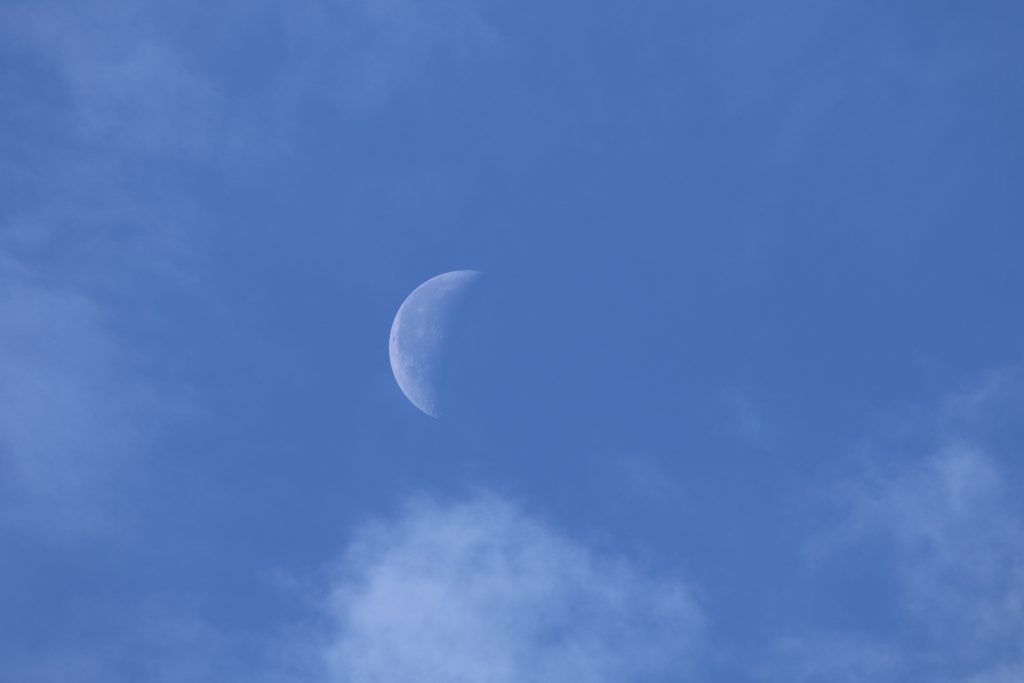Three Moons for June
Three moon-ridden social media posts for the convenience and amusement of visitors to my humble blog.

June 8, 2020
Waxing moon over New England.
It is all future. It implies nothing present. That is how it charms. Some folks form intentions during this phase, but the waxing moon itself forms none. It but points to the possibility of intention’s fulfillment, drawing you forward but never feeling like a promise so much as a mark on the way.
Also, here is an invisible veil about to be pierced – or maybe blown open to take you with it.
The waxing moon manages to be in motion, in change, while at the same time perfect and unchanging in itself. And so it proclaims divinity’s eternal tension with creation. It must perform this mystery every month, by universal law.
Here is the high priestess in the Rider Waite tarot deck. A scrying bowl. Horns from an ancient animal that died thousands of years ago and whose energy a shaman-artist transferred into cave paintings. A celestial seat for fairies, à la The Fairy of the Moon by Hermann Kaulbach (1891) (see earlier post).
And in the Enemy Glory trilogy, magical research. That is, intellectual curiosity and the process of acquiring learning and experience. Also (good) wizardry, and philosophy leading to an ethics of lawful good. Intentions, sure. Mirand, Llewelyn’s first teacher, is associated with this phase. So is his goddess, Athena.
Some witches associate the waxing moon with the Maiden archetype, with Persephone prior to her underworld ordeal. But Maidens needn’t be young nor naive. Let’s call it increase – periods of life in which things feel like they are reaching into more experienced versions of themselves. Nothing comes toward you, but you feel yourself drawn toward everything, including versions of yourself you’ve yet to meet navigating half-lit paths you’ve yet to see.

June 23, 2020
Full moon over Greenwich Cove, Rhode Island.
It has no truck with the past, nor traffic with the future. It is entirely present, revealing and obscuring an eternal now, hinting at the light that the folks who survive death swear they encounter, but can neither forget nor describe.
Here, the illusion of separation blinks. And so you sense the life of things without needing to name them. The full moon shines through the veil between the worlds and renders it invisible. That is why it transfixes while failing to charm.
Animals and humans howl, chant, and form circles; clumsy attempts to mirror What Is and know themselves, briefly, as ongoing manifestations of God. Singing, clapping, spinning, healing, falling back to ground and limitations. This sort of thing has been happening since at least the late Neolithic.
Some associate the full moon with the Mother archetype. But moon goddesses tend to be virgins. Artemis gives birth to nothing, remaining free. Yet she presides at all births, midwifing new lives into the world of separation like so many characters into a work of fiction. The sloshy nature of mystic play costumes itself in the physical. What we see is all show; an awkward actor pointing up the literal to convey to the imagination the fuzzy light of truth.
“All that I have to say, is, to tell you that the lanthorn is the moon; I, the man in the moon; this thorn-bush, my thorn-bush; and this dog, my dog.” — Robin Starveling, as Moonshine in Shakespeare’s A Midsummer Night’s Dream
So here is, well, the moon. In the tarot, The Moon. Who, showing all things, sheds teardrops of light like her opposite, the sun. In song and poetry and myth, the moon. Always and only the moon. Imagination creating and becoming Everything, what Blake called “conversing with Paradise.”
And in the Enemy Glory trilogy, Aeren the bard, who transforms into different genders, creatures, characters, and yet remains unrecognized for the tale-teller she is, shares scenes with the full moon. That she recognizes no divinity save her own imagination makes no difference. It’s more or less the point.

June 29, 2020
Moon waning over early morning.
It is wholly past. Even its light is backward, a morning-after remnant of its earlier phases. But so removed from its sources . . . so aloof . . . it draws nothing from whence it came. After the full moon’s intensity, its relentless revelation of Experience (see previous post), comes breakage. Separation.
It is the quietest of the three moons (see previous posts), and so, like most introverts, unnoticed. Many don’t associate the moon with daylight or blue skies; and so they never see what it does after dawn. Others are surprised to learn that yes, you really can see the moon by day. If it’s ending things. If it’s dying.
So here is the Crone. Crones needn’t be old or female, just wise and disregarded. Young, cursed Cassandra, forever speaking truth and forever disbelieved. That happens when Apollo spits in your mouth. Hypatia teaching science in the nascent face of the Church.
But any outsider will do. Coleridge’s Ancient Mariner. Frankenstein’s poor monster. Melville’s Ishmael. “And I only am escaped alone to tell thee.” Mourners. Witches.
Survivors of the unspeakable have no shared language with the rest of humanity. There is only breakage – and then a solitude poorly translated.
In the Enemy Glory trilogy, the waning moon is Hecate’s symbol, and therefore Llewelyn’s. It’s burnt into his palm, marking him as evil for grasping at magic, at learning, at beauty, at a life imagined and inexplicably denied. Damned before he knows what it means. Telling his story to his enemy as he dies.
______________________________________________________________________________
You are reading a post from Matter Notes, Karen Michalson’s blog on creativity as spirituality and the war on the humanities. Her most recent novel, The Maenad’s God, is available on Amazon.
Subscribe to her mailing list (bottom of page) and receive a free copy of Enemy Glory (Book One), the first book of her Enemy Glory trilogy.
